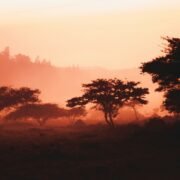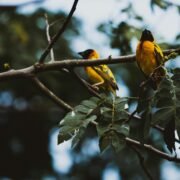
Gorillas & Chimpanzees in Uganda and Rwanda
Secrets of the Jungle Kingdoms
Uganda and Rwanda stand among the finest destinations in Africa for travellers who dream of meeting primates in their natural environments. These two countries are renowned for offering unforgettable encounters with the magnificent mountain gorillas and the highly intelligent chimpanzees. Venturing into the forests in search of these primates is not only a remarkable adventure but also a deeply moving experience that connects visitors to the heart of the wild.
The Mountain Gorillas of Uganda and Rwanda
Hidden within the thick rainforests and cloud covered mountains of central Africa live the endangered mountain gorillas. These gentle giants are found only in a few protected areas across Uganda, Rwanda and the Democratic Republic of Congo, with Uganda and Rwanda being the most accessible and popular destinations for visitors.
Uganda’s Bwindi Impenetrable National Park
Uganda is home to almost half of the world’s remaining mountain gorilla population. The majority live in the ancient Bwindi Impenetrable National Park, a UNESCO World Heritage Site that is famed for its incredible biodiversity. Bwindi is a true jungle, with dense vegetation, tangled vines and mist drifting through the trees, creating an atmosphere of mystery and adventure.
Within Bwindi, more than twenty gorilla families have been habituated to human presence, allowing visitors to trek deep into the forest with guides and trackers in search of them. The experience of coming face to face with a gorilla family is beyond words. The sight of a mighty silverback calmly watching over his group, mothers cradling their young and playful juveniles tumbling around is one of the most extraordinary wildlife moments in the world.
Rwanda’s Volcanoes National Park
Across the border in Rwanda lies Volcanoes National Park, part of the larger Virunga Conservation Area. This dramatic landscape of volcanic peaks and lush bamboo forests is one of the most iconic gorilla habitats. Rwanda has invested heavily in conservation and tourism, ensuring that gorilla encounters here are well organised and sustainable.
The treks in Volcanoes National Park are often shorter compared to Bwindi, but they are equally rewarding. The park is strongly associated with the legacy of Dian Fossey, the renowned primatologist who dedicated her life to studying and protecting mountain gorillas. Visiting Volcanoes National Park is not only about meeting gorillas but also about stepping into a place of history, conservation and breath taking scenery.
The Chimpanzees of Uganda and Rwanda
Although gorillas often receive the most attention, chimpanzees are equally fascinating and provide a completely different primate encounter. Chimpanzees share around ninety eight percent of their DNA with humans, and observing them in the wild is like looking into a mirror of our own behaviour.
Chimpanzees in Uganda
Uganda is regarded as the primate capital of Africa, with more than twenty primate species found in the country. It is the best place on the continent to see chimpanzees in the wild.
The most popular destination for chimpanzee trekking is Kibale Forest National Park, which holds the highest density of chimpanzees in Africa. The forest is teeming with life, from rare monkeys and colourful birds to butterflies and towering fig trees. Treks through Kibale are lively and fast paced, as chimpanzees move swiftly through the canopy. The excitement of hearing their loud calls echoing through the forest before suddenly spotting them high in the branches or feeding on the forest floor is unforgettable.
Beyond Kibale, visitors can also track chimpanzees in Budongo Forest near Murchison Falls National Park and in Kyambura Gorge, a sunken rainforest within Queen Elizabeth National Park. Each location offers a unique landscape and atmosphere, providing different perspectives of chimpanzee behaviour.
Chimpanzees in Rwanda
In Rwanda, chimpanzees can be observed in the vast and ancient Nyungwe Forest National Park. This high altitude rainforest is one of the oldest in Africa and is home to around five hundred chimpanzees. The terrain here is more challenging, with steep slopes and thick undergrowth, but the reward of finding a troop of chimpanzees swinging energetically through the trees is beyond compare. Nyungwe is also a haven for other primates, including colobus monkeys and mangabey, as well as hundreds of bird species, making it a paradise for nature enthusiasts.
Why Visit Uganda and Rwanda for Gorilla and Chimpanzee Safaris
There are many reasons why Uganda and Rwanda are unmatched for primate experiences.
Conservation Impact: Every trekking permit purchased directly supports the protection of these endangered animals and funds community development projects around the parks. By visiting, travellers contribute to safeguarding the future of gorillas and chimpanzees.
Unparalleled Biodiversity: Beyond gorillas and chimpanzees, both countries boast extraordinary biodiversity. Visitors can expect to encounter golden monkeys, rare bird species, dazzling butterflies and a rich variety of forest flora.
Cultural Connections: Uganda and Rwanda also offer vibrant cultural experiences. From visiting the Batwa community near Bwindi to exploring Rwanda’s cultural heritage and traditions, a primate safari can be combined with meaningful cultural journeys.
The Ultimate Primate Safari
For wildlife lovers and adventurous travellers, combining gorilla trekking in Bwindi or Volcanoes National Park with chimpanzee trekking in Kibale or Nyungwe creates the ultimate primate safari in East Africa. Few experiences on earth rival the privilege of sitting quietly among a family of gorillas or following the lively movements of a troop of chimpanzees through the forest. These encounters are not only thrilling but also deeply humbling, reminding us of our close connection to the natural world.
Whether it is the towering volcanic landscapes of Rwanda or the mist filled jungles of Uganda, a journey to see gorillas and chimpanzees will leave lasting memories and stories to treasure for a lifetime.



